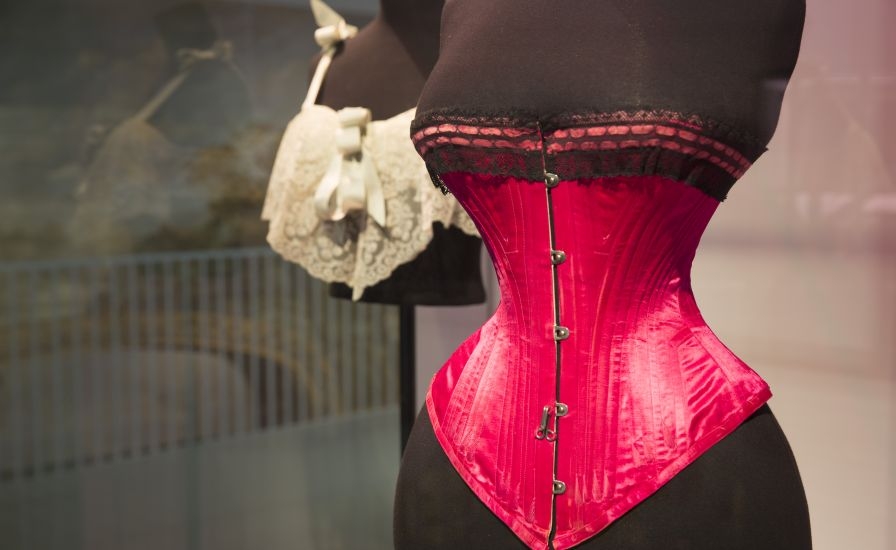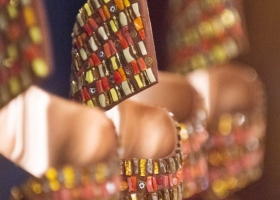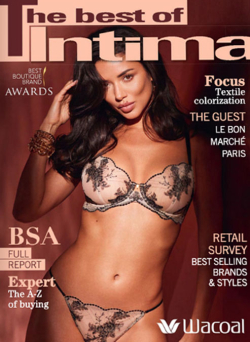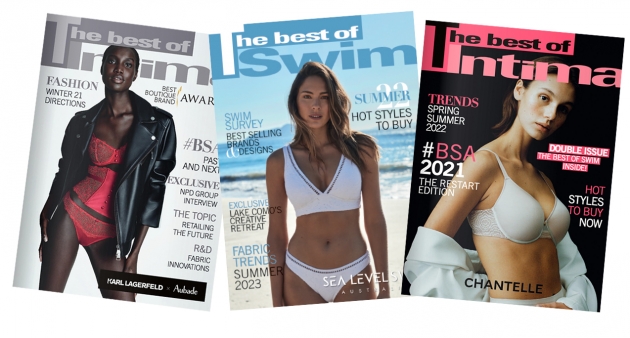
The Best ofIntima & Swim Edit
UNDRESSED A Brief History of Underwear
16 January 2017
London's famous Victoria and Albert Museum's current exhibition 'Undressed: A Brief History of Underwear' traces the history of underwear design from the 18th century to present day.

Sponsored by luxurious lingerie brand Agent Provocateur and cosmetics giant Revlon, the unmissable exhibition unravels three centuries of history, exploring underwear's role in protecting and enhancing the body while also considering the practical, personal, sensory and fashionable sides of underwear. There are more than 200 examples of men and women's underwear on display including a rare example of an 18th-century corset typically worn by working women in England and pieces from designers such as Stella McCartney, La Perla, Rigby & Peller and Paul Smith. The diverse collection explores themes such as innovation and luxury. Find a selection of images from this fantastic retrospective here or if you happen to be in London see it with your own eyes, but you be better be quick as the exposition closes on the 7th of March.

Get Up Close and Personal with A Rare Collection of Intimate Apparel
'Undressed' explores the relationship between underwear and fashion, the concept of the ideal body and the ways that the style, fit, and fabric can be used to explore issues of gender, sex, and morality. Focusing on complex themes such as health and hygiene, the exposition will address the design and technological advances central to the development of underwear. Corsets, crinolines, boxer shorts, bras, hosiery, lingerie, and loungewear will all be on display next to contextual fashion plates, photographs, advertisements, display figures and packaging. Many extremely rare pieces are on display and highlights include long cotton drawers worn by Queen Victoria's mother, an 1842 men's waist belt which would have traditionally been worn on the owner's wedding day, a 1960s Mary Quant body stocking, a pair of gender neutral briefs by Acne, a sheer dress by Liza Bruce which was made famous by Kate Moss, and flesh-colored leggings decorated with a mirrored glass fig leaf by Vivienne Westwood.
The Corset
It is impossible to trace the history of underwear without examining the corset. Undressed cleverly brings to light the debates around one of the most controversial styles of underwear, the corset, while considering how they can be worn today in a healthy way. A 1890s whalebone and cotton corset with a tiny waist circumference that is unbelievably smaller than 19 inches is on display next to x-rays and illustrations that highlight the dramatic impact of corsets on the body. On the other hand, corsets also have medical uses and can be used to correct posture. In order to explore this side of corsetry, the exhibition also includes a lightly boned corset from 1895 which is made from artex, an innovative cellular woven cotton. An austerity corset crafted from paper during World War One is also on display, alongside, more modern examples of corsetry such as a waist-training corset, a slimming tool used by celebrities such as Kim Kardashian.

Bras throughout the 20th century
Bras were originally developed in order to enable movement and mobility but by combining vintage bras with modern examples, 'Undressed: A Brief History of Underwear' not only traces the history of the bra but also how the bra has evolved to meet a variety of demands. Early examples include a lace and satin bust bodice from 1910 but different bras, girdles and shapewear illustrate the importance and variety of support over the years, ranging from advertisements for latex corsetry from the 1930s brand Chamaux to a 1950s Playtex rubber girdle and designs from 2010 by Spanx.
Luxury Lingerie
Visitors can equally find examples of lingerie made from luxurious materials. An amazingly detailed pair of 1930s silk chiffon knickers with lace detailing which depicts a hunting scene, underlines how the finest fabrics and exceptional craft skills work together to make luxury underwear. Garters and hosiery are also on display, most notably including a pair of floral embroidered stockings worn by Queen Alexandra, the wife of King Edward VII, Schiaparelli nylon stockings from 1953 and embroidered stockings which were originally exhibited at the Universal Exhibition in Paris in 1900.

The Evolution of Comfort
The exhibition also demonstrates how underclothes and nightwear evolved into loungewear. Visitors can discover how dressing gowns became informal garments for entertaining at home such as tea and hostess gowns through the key pieces on display such as an 1840's male dressing gown, a silk evening dress by Paul Poiret from 1911 which lead to the popular 1920s chemise dress, a chic 1930s jumpsuit by London fashion house Baroque and a pair of embroidered lounge pyjamas dating back to the 1920s. A pink Juicy Couture tracksuit from 2004 and a men's T-shirt and pant set by Sibling (S/S 2013) illustrate the continuing desire for comfort at home and the blurring of the boundaries between underwear and outerwear, public and private.
Function and Performance
Everyday underwear is not left out, and the exhibition focuses on the materials used over the last three centuries to create comfortable, yet, functional underwear. Visitors can discover an 1850s cotton chemise, examples of artificial silk from the 1920s and a contemporary set of modal pants for women by Cheekfrills which has been playfully embroidered with the days of the week. The importance of performance is underlined through displays of maternity underwear, underclothes that keep you warm or cool, and sportswear. Key pieces include a homemade bust bodice for a nursing mother from the 1820s, a contemporary set of maternity lingerie by Hot Milk, a 1970s pair of men's red string briefs by Brynje of Norway, a 'Cyclist Corset' and its box from 1900 and a 1990s sports bra from British department store Marks and Spencer. A special focus on men's underwear shows the importance of fit and shows packaging for a pair of David Beckham for H&M briefs from 2012, and a display figure for Y-front pants dating back to the 1950s. These objects are intended to underline the connection that underwear advertising makes between itself and the appeal of a youthful, fit, sexually attractive body.
Transform the Body
Underwear is often used to lift, separate or exaggerate parts of the body in order to create a fashionable silhouette. Rare 18th-century hoops are on display alongside crinolines and bustles. Many of the pieces, shown alongside their original advertising materials, were created in response to customer's demands for undergarments which did not restrict movement, such as a clever collapsing bustle. The use of underwear to add volume to certain parts of the body is an important theme throughout the exhibition, illustrated by a display of men's briefs by aussieBum from 2015, created specially to enhance the genitals, and a woman's push-up bra from the 1990s. A series of funny stereoscopic images, which show the dangers of wearing crinolines, is also on display.

Underwear as Outwear
By definition, underwear is worn beneath other clothes. Designers are often fascinated by the relationship between underwear and outerwear. The pieces on display reflect the debates on what can be worn in public, gender, sex, and nudity. While in the past shirts, chemises and petticoats were sometimes revealed to indicate the wealth of the owner, since the 20th century, exposed underwear has been a common sight. This is explored through key pieces on display such as a Calvin Klein crop top and briefs worn with low-slung hot pants, and an embroidered, transparent dress worn with beautiful lace knickers by John Galliano for Givenchy haute couture (S/S 1996).
From Seduction to Provocation
Corsets and lingerie are often designed to be alluring, seductive or playful, to enable wearers to express their desires and fantasies. 'Undressed: A Brief History of Underwear' explores the tempting nature of underwear through many different styles and types, ranging from a vivid pink silk 1890s corset to 1930s bias cut underwear, contemporary pieces by Cadolle, Fifi Chachnil and Agent Provocateur, and an exquisite negligée by Carine Gilson, which is the same as the one worn by Bérénice Marlohe in the film 'Skyfall.' The collection comes together to illustrate that the choice of underwear for the bedroom has always been a fundamentally personal decision.
As much as underwear can be revealed, it is also often designed to transform or provoke. Alongside Vivienne Westwood's iconic flesh-colored leggings there is a skin-tight laced cocktail dress by Jean Paul Gautier from 1989, a delicate lace dress by Ellie Saab (S/S 2011), a Dolce & Gabbana dress featuring a large cage crinoline (S/S 2013) from their Sicilian Collection, and Antonio Beradi's monochrome dress (S/S 2009), made famous by Gwyneth Paltrow and featuring a trompe l'oeil corset which reveals the underwear worn beneath.
Related articles:
Copyright 2025. All right reserved - Terms










